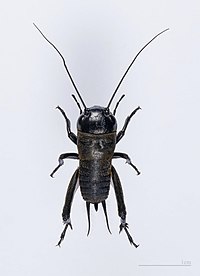
Photo from wikipedia
The properties of biochar (BC) from crustacean chitin are relatively well understood, while there are few studies on BC from insect chitin. This study presents the characterization and phytotoxic assessment… Click to show full abstract
The properties of biochar (BC) from crustacean chitin are relatively well understood, while there are few studies on BC from insect chitin. This study presents the characterization and phytotoxic assessment of BC produced from crickets and cricket chitin. Cricket powder (BCCR) and cricket chitin (BCCH) were pyrolyzed at 500 °C and 700 °C. Physicochemical characteristics, N ad-/desorption, FTIR, were examined. SEM images were also performed. Regardless of the pyrolysis temperature, biochars were characterized by a densely “packed” solid surface/monolithic type with a non-porous structure (0.05–0.22 m2/g) and high content of N (9.4–11.8%). BCCHs showed a higher pH (12.2–12.4) compared to BCCR (8.7–10.8). Based on the XRD analysis, BCs were characterized by an amorphous carbon turbostratic structure and a randomly oriented graphitic-like micro-crystallite structure. FTIR spectra of BCs confirmed the presence of various O2 and N-functional groups on the BC surface. BCCHs added to soil at rates from 0.5 to 1.5% significantly reduced the germination of Lepidium sativum. Stimulation of root elongation was also observed in the case of BCCR500 1.0% and BCCR700 1.5%. Thermal degradation of cricket powder and cricket chitin promotes the formation of organic N-containing heterocyclic rings, which lead to the production of N-doped carbons with potential uses in energy storage and the contaminations sorption.
Journal Title: Molecules
Year Published: 2022
Link to full text (if available)
Share on Social Media: Sign Up to like & get
recommendations!